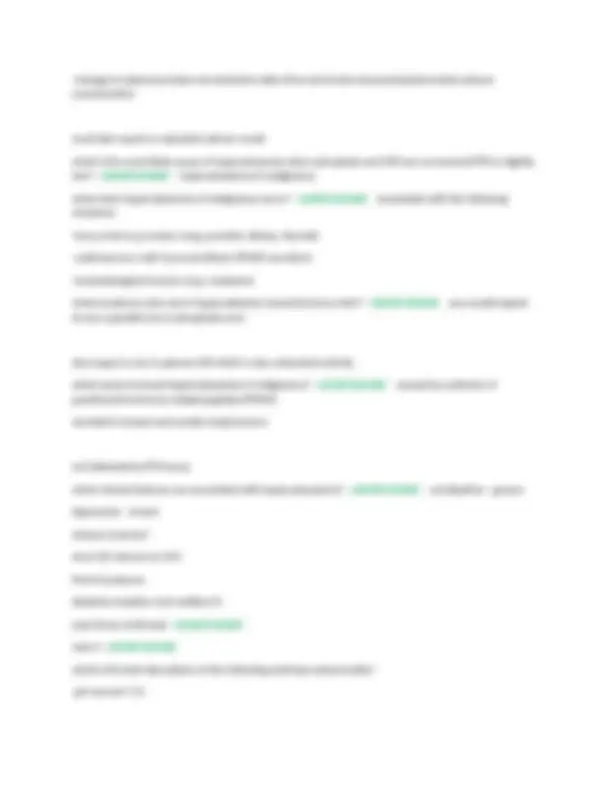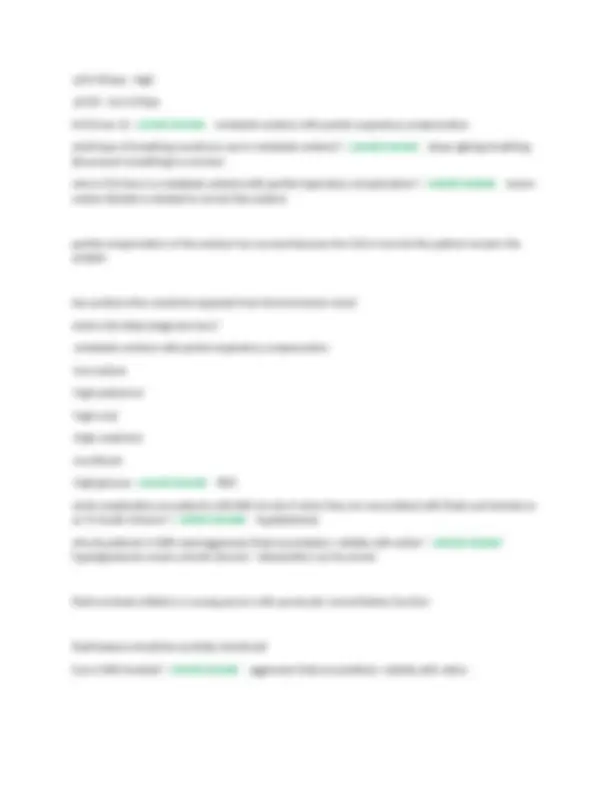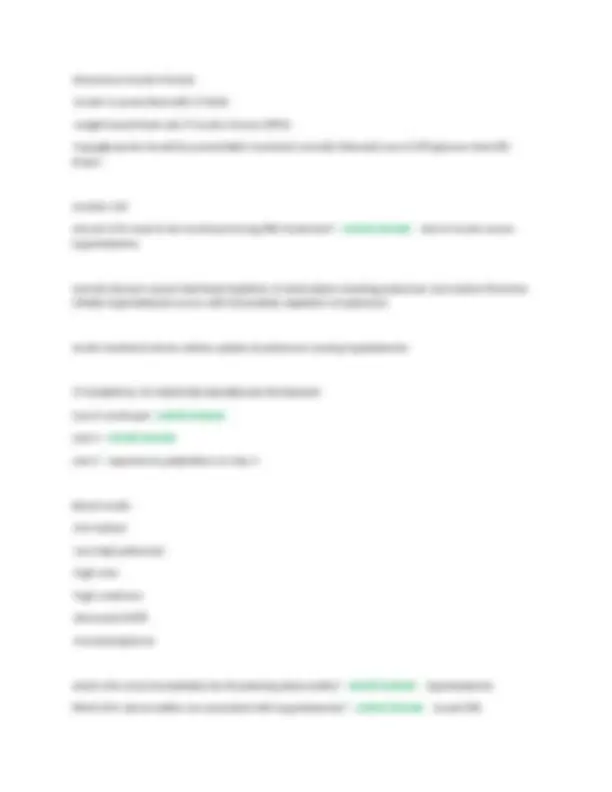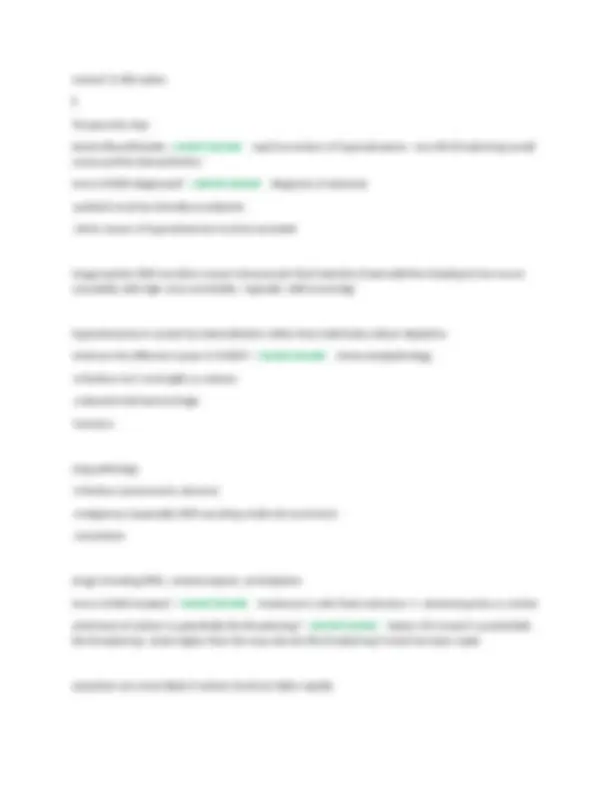







Study with the several resources on Docsity

Earn points by helping other students or get them with a premium plan


Prepare for your exams
Study with the several resources on Docsity

Earn points to download
Earn points by helping other students or get them with a premium plan
Community
Ask the community for help and clear up your study doubts
Discover the best universities in your country according to Docsity users
Free resources
Download our free guides on studying techniques, anxiety management strategies, and thesis advice from Docsity tutors
case study tutorials on clinical chemistry
Typology: Exams
1 / 9

This page cannot be seen from the preview
Don't miss anything!






case 1 - what is the best description of the pattern of these results? -bilirubin high -ALT & ALP moderately raised -ALP very high 4 x the normal range -albumin very slightly low -gamma GT very high 15 x normal range - correct answer cholestatic picture in obstructive jaundice - what will the ratio of conjugated to unconjugated bilirubin be? - correct answer more conjugated than unconjugated this is because the liver is ok and the problem lies beyond the liver, so the liver can still conjugated the bilirubin what are the common causes of cholestatic jaundice? - correct answer caused by bile duct obstruction -malginancy (cholangiocarcinoma, pancreatic carcinoma) -gallstones -sclerosing cholangitis -pancreatitis +/- pseudocyst what are the important clinical features of cholestatic jaundice? - correct answer painful (gallstones, pancreatitis) vs painless bilirubin clinically detectable at >50 umol/L pale stools and dark urine ALP >> ALT conjugated bilirubin > unconjugated case 1 -56 yo man -malaise and pruritis -unwell over few weeks
-urine dark -obstructive picture what is the most likely cause of jaundice? - correct answer carcinoma of the head of the pancreas case 2 - correct answer what abnormality do these results show? -low T3 and T -v high TSH 8 x normal range - correct answer primary hypothyroidism what is the cut off for bilirubin becoming visible? - correct answer 50 how is hypothyroidism managed? - correct answer diagnosis of hypothyroidism is made and the patient is prescribed levothyroxine 50 micrograms orally daily tests are sent for serum anti-thyroid perioxidase to test for autoimmune thyroid disease case 2 continued - correct answer case 2 continued etc - correct answer due to intermittent compliance with levothyroxine what is the earliest time at which repeat thyroid function testing is indicated i.e. full effects of levothyroxine treatment will be seen - correct answer 4 weeks In the majority of cases TFTs should be checked no sooner than 4 weeks after initiation or change of thyroid medication case 3 - correct answer if calcium is 2.88 and albumin is 24 g/L - what is the adjusted calcium conc? - correct answer 3. mmol/L how is plasma calcium conc adjusted for using albumin? - correct answer calcium is present in two main forms -calcium bound to proteins (principally albumin) -free ionised calcium (Ca2+)
-pO2 18 kpa - high -pCO2 - low 2.8 kpa hCO3 low 12 - correct answer metabolic acidosis with partial respiratory compensation what type of breathing would you see in metabolic acidosis? - correct answer deep sighing breathing (Kussmaul's breathing) is common why is CO2 low in a metabolic acidosis with partial respiratory compensation? - correct answer excess carbon dioxide is exhaled to correct the acidosis partial compensation of the acidosis has occured because the CO2 is low but the patient remains the acidotic less acidosis than would be expected from the low bicarb result what is the likely diagnosis here? -metabolic acidosis with partial respiratory compensation -low sodium -high potassium -high urea -high creatinine -low Bicarb -high glucose - correct answer DKA what complication are patients with DKA at risk of when they are resuscitated with fluids and started on an IV insulin infusion? - correct answer hypokalaemia why do patients in DKA need aggressive fluid resuscitation, initially with saline? - correct answer hyperglycaemia causes osmotic diuresis - dehydration can be severe fluid overload unlikely in a young person with previously normal kidney function fluid balance should be carefully monitored how is DKA treated? - correct answer aggressive fluid resuscitation, initially with saline
intravenous insulin infusion -insulin co-prescribed with IV fluids -weight-based fixed rate IV insulin infusion (FRIII) -hypoglycaemia should be preventable if protocol correctly followed (use of 10% glucose when BG drops) monitor U/E why do U/Es need to be monitored during DKA treatment? - correct answer lack of insulin causes hyperkalaemia osmotic diuresis causes total body depletion of electrolytes including potassium and sodium therefore initially hyperkalaemia occurs with intracellular depletion of potassium insulin treatment drives cellular uptake of potassium causing hypokalaemia IT'S ESSENTIAL TO MONITOR AND REPLACE POTASSIUM Case 4 continued - correct answer case 5 - correct answer case 5 - experiences palpitations on day 3 blood results -low sodium -very high potassium -high urea -high creatinine -decreased eGFR -increased glucose what is the most immediately low threatening abnormality? - correct answer hyperkalaemia Which ECG abnormalities are associated with hyperkalaemia? - correct answer broad GRS
sepsis drugs (NSAIDs, ACEi, contrast agents) symptoms of urinary obstruction case 6 - correct answer CXR confirms the presence of a large right sided pleural effusion, with an opacity in the right lower zone You phone his GP who tells you that he is on bendroflumethiazide for hypertension , and has a 40 pack year smoking history case 6 - what is the most likely cause of his hyponatraemia? TSH high fT4 normal cortisol high serum osmolality low urine urine osmolality and sodium?? - correct answer SIADH = syndrome of inappropriate ADH secretion most likely caused by an ADH secreting lung tumour which of the following interventions in case 6 should not be considered? Demeclocycline B. Drainage of pleural effusion C. Fluid restriction D. Rapid correction of hyponatraemia with 'twice
normal' (1.8%) saline E. Temporarily stop bendroflumethiazide - correct answer rapid correction of hyponatraemia - very life threatening would cause pontine demyelination how is SIADH diagnosed? - correct answer diagnosis of exclusion -patients must be clinically euvolaemic -other causes of hyponatraemia must be excluded inappropriate ADH secretion causes intravascular fluid retention/haemodilution leading to low serum osmolality with high urine osmolality - typically >600 mosm/kg) hyponatraemia is caused by haemodilution rather than total body sodium depletion what are the different causes of SIADH? - correct answer intracranialpathology -infections incl. meningitis or asbcess -subarachnoid haemorrhage -tumours lung pathology -infections (pneumonia, abscess) -malignancy (especially ADH secreting small cell carcinoma) -sarcoidosis drugs including SSRIs, carbamazepine, amitriptyline how is SIADH treated? - correct answer treatment is with fluid restriction +/- demeclocycline or similar what level of sodium is potentially life threatening? - correct answer below 115 mmol/L is potentially life-threatening - levels higher than this may also be life threatening if onset has been rapid symptoms are more likely if sodium level has fallen rapidly